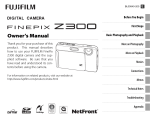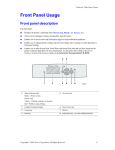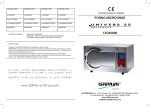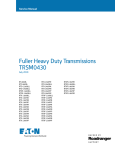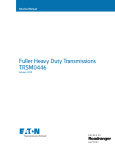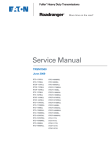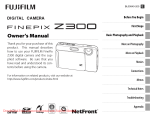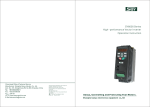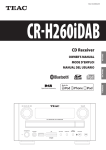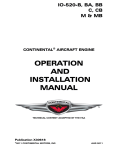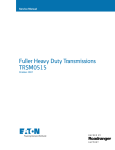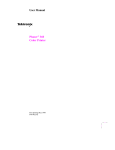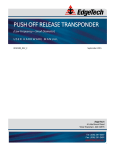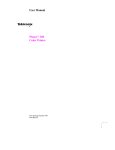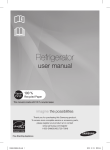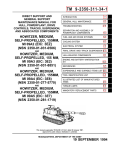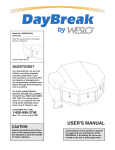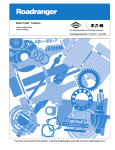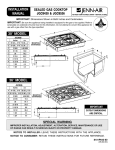Download For the most current information, visit the Roadranger web
Transcript
Eaton ® Fuller ® Heavy Duty Transmissions 6613 Series Service Manual TRSM-0600 August 1986 For the most current information, visit the Roadranger web site at www.roadranger.com TABLE OF CONTENTS FOREWARD . . . . . . . . . . . . . . . . . . . . . . . . . . . . . . . . . . . . . . . . . . . . . . . . . . . . . . . . . . . . . . . . . . ...2 MODEL DESIGNATIONS AND SPECIFICATIONS . . . . . . . . . . . . . . . . . . . . . . . . . . . . . . . . . . . ...3 LUBRICATION . . . . . . . . . . . . . . . . . . . . . . . . . . . . . . . . . . . . . . . . . . . . . . . . . . . . . . . . . . . . . . . . ...4 OPERATION . . . . . . . . . . . . . . . . . . . . . . . . . . . . . . . . . . . . . . . . . . . . . . . . . . . . . . . . . . . . . . . . . . ...6 POWER FLOW . . . . . . . . . . . . . . . . . . . . . . . . . . . . . . . . . . . . . . . . . . . . . . . . . . . . . . . . . . . . . . . . ...8 TIMING . . . . . . . . . . . . . . . . . . . . . . . . . . . . . . . . . . . . . . . . . . . . . . . . . . . . . . . . . . . . . . . . . . . . . ...11 TORQUE RECOMMENDATIONS . . . . . . . . . . . . . . . . . . . . . . . . . . . . . . . . . . . . . . . . . . . . . . . . ...12 TOOL REFERENCE . . . . . . . . . . . . . . . . . . . . . . . . . . . . . . . . . . . . . . . . . . . . . . . . . . . . . . . . . . . ...14 PREVENTIVE MAINTENANCE . . . . . . . . . . . . . . . . . . . . . . . . . . . . . . . . . . . . . . . . . . . . . . . . . . ...15 PRECAUTIONS DISASSEMBLY . . . . . . . . . . . . . . . . . . . . . . . . . . . . . . . . . . . . . . . . . . . . . . . . . . . . . . . . . . . ...17 INSPECTION . . . . . . . . . . . . . . . . . . . . . . . . . . . . . . . . . . . . . . . . . . . . . . . . . . . . . . . . . . . . . ...17 REASSEMBLY . . . . . . . . . . . . . . . . . . . . . . . . . . . . . . . . . . . . . . . . . . . . . . . . . . . . . . . . . . . . ...18 AIR SYSTEM OPERATION AND TROUBLESHOOTING . . . . . . . . . . . . . . . . . . . . . . . . . . . . . . . . . . . . . ...19 WITH 3-POSITION SELECTOR VALVE . . . . . . . . . . . . . . . . . . . . . . . . . . . . . . . . . . . . . . . ...24 WITH A-5015 ROADRANGER VALVE . . . . . . . . . . . . . . . . . . . . . . . . . . . . . . . . . . . . . . . . ...27 AI R SYSTEM SCHEMATICS . . . . . . . . . . . . . . . . . . . . . . . . . . . . . . . . . . . . . . . . . . . . . . . ...30 DISASSEMBLY–SHIFTING CONTROLS AI R SYSTEM . . . . . . . . . . . . . . . . . . . . . . . . . . . . . . . . . . . . . . . . . . . . . . . . . . . . . . . . . . . . . ...36 GEARSHIFT LEVER HOUSING . . . . . . . . . . . . . . . . . . . . . . . . . . . . . . . . . . . . . . . . . . . . . ...42 SHIFT BAR HOUSING ASSEMBLY . . . . . . . . . . . . . . . . . . . . . . . . . . . . . . . . . . . . . . . . . . ...44 DISASSEMBLY - COMPANION FLANGE AND CLUTCH HOUSING . . . . . . . . . . . . . . . . . . . . .47 DISASSEMBLY - AUXILIARY REAR HOUSING . . . . . . . . . DISASSEMBLY - AUXILIARY INTERMEDIATE HOUSING DISASSEMBLY - FRONT SECTION . . . . . . . . . . . . . . . . . . . REASSEMBLY - FRONT SECTION . . . . . . . . . . . . . . . . . . . REASSEMBLY - AUXILIARY INTERMEDIATE HOUSING . REASSEMBLY - AUXILIARY REAR HOUSING . . . . . . . . . . REASSEMBLY - COMPANION FLANGE AND CLUTCH HOUSING . . . . . . . . . . . . . . . . . . . . .101 REASSEMBLY - SHIFTING CONTROLS SHIFT BAR HOUSING . . . . . . . . . . . . . . . . . . . . . . . . . . . . . . . . . . . . . . . . . . . . . . . . . . . ...102 GEAR SHIFT LEVER HOUSING . . . . . . . . . . . . . . . . . . . . . . . . . . . . . . . . . . . . . . . . . . . ...105 AIR SYSTEM . . . . . . . . . . . . . . . . . . . . . . . . . . . . . . . . . . . . . . . . . . . . . . . . . . . . . . . . . . . . ...106 1 FOREWORD service information for these and other Fuller Transmissions are available upon request. A Technical Literature Order Form may be found in the back of this manual. You may also obtain Service Bulletins, detailing information on product improvements, repair procedures and other service-related subjects by writing to the following address: This manual is designed to provide detailed information necessary to service and repair the Fuller @ Transmission listed on the cover. As outlined in the Table of Contents, the manual is divided into 3 main sections: a. Technical information and reference b. Removal, disassembly, reassembly and installation c. Options The format of the manual is designed to be followed in its entirety if complete disassembly and reassembly of the transmission is necessary. But if only one component of the transmission needs to be repaired, refer to the Table of Contents for the page numbers showing that component. For example, if you need to work on the Shift Bar Housing, you will find instructions for removal, disassembly and reassembly on page 19. Instructions for installation are on page 55. Service Manuals, Illustrated Parts Lists, Drivers Instructions, and other forms of product EATON CORPORATION TRANSMISSION DIVISION Technical Service Department P.O. Box 4013 Kalamazoo, MI 49003 (61 6) 342-3344 Every effort has been made to ensure the accuracy of all information in this brochure, However, Eaton Transmission Division makes no expressed or implied warranty or representation based on the enclosed information. Any errors or omissions may be reported to Training and Publications, Eaton Transmission Division, P.O. Box 4013, Kalamazoo, Ml 49003. 2 MODEL DESIGNATIONS AND SPECIFICATIONS Nomenclature: RTO-6613 Letter Designations Number Designations Roadranger Forward Speeds Twin Countershaft Multi-Mesh Gearing Overdrive x 100 = Nominal Torque Capacity IMPORTANT: All Fuller Transmissions are identified by model and serial number. This information is stamped on the transmission identification tag and affixed to the case. DO NOT REMOVE OR DESTROY THE TRANSMISSION IDENTIFICATION TAG. Specifications: Low Model No. Speeds 1 St 2nd Intermediate 3rd 4th 5th 6th 7th (Note 1) Relative Speed PTO Gear To Input R.P.M. Gear Ratios High 8th 9th 10th 11th 12th 13th Reverse Right Bottom (Note 2) Length In. mm (Note 2) Weight Lbs. kg (Note 3) Oil Cap. Pints Liters RT-6613 13 17.93 14.04 10,96 8,61 6.74 5.26 4.11 3.29 2.61 2.05 1.60 1.25 1.00 2.78/9.15 19.06 720 .720 32.7 830 556 252 16 8 RTO-6613 13 14.38 11.26 8.78 6.90 5.41 4.22 3.29 2.64 2.10 1.64 1.28 1.00 2.23/7.34 15,28 .898 .898 32.7 830 556 252 16 8 .80 See Chart Notes. CHART NOTES: P.T.O. Gears - 6613 Series transmissions have a 33-tooth PTO gear, both right side and bottom. All models have 6/8 pitch PTO gears. 2. Length - Listed lengths are installation dimensions from face of clutch housing to front of bottoming surface of companion flange or yoke. 3 . Weight - Listed weights are without clutch housing*. Weights include standard controls, which consist of gear shift lever housing, gear shift lever, range controls and attaching lines. Weight of standard controls is approximately 10 lbs. (4.5 kg). All weights are approximate. 4. Oil Capacity - Oil capacities are approximate, depending on inclination of transmission. Always fill transmission to level of filler opening. Refer to Publication Form 121- “Lubrication Recommendations” for further information. *For information on available clutch housings refer to Publication FUL-140-’’Clutch Housing Chart”. \ Proper Lubrication . . . the Key to long transmission life I Recommended Lubricants Type Grade (SAE) Heavy Duty Engine Oil MIL-L-2104B, C or D or 50 API-SF or API-CD 40 (Previous API designations 30 acceptable) Mineral Gear Oil with rust 90 and oxidation inhibitor 80W API-GL-1 Proper lubrication procedures are the key to a good all-around maintenance program. If the oil is not doing its job, or if the oil level is ignored, all the maintenance procedures in the world are not going to keep the transmission running or assure long transmission life. Fuller® Transmissions are designed so that the internal parts operate in a bath of oil circulated by the motion of gears and shafts. Thus, all parts will be amply lubricated if these procedures are closely followed: Fahrenheit (Celsius) Ambient Temperature o o Above 10 F(-12 C.) o o Above 10 F(-12 C.) o o Below 10 F(-12 C.) o o Above 10 F(-12 C.) o o Below 10 F(-12 C.) The use of mild EP gear oil or multi= purpose gear oil is not recommended, but ‘if these ‘gear oils are used, be sure to adhere to the following limitations: Do not use mild EP gear oil or multi-purpose gear oil when operating temperatures are above 230oF (110oC). Many of these gear oils, particularly 85W140, break down above 230°F and coat seals, bearings and gears with deposits that may cause premature failures. If these deposits are observed (especially a coating on seal areas causing oil leakage), change to heavy duty engine oil or mineral gear oil to assure maximum component life and to maintain your warranty with Eaton. (Also see “Operating Temperatures”.) 1. Maintain oil level. Inspect regularly. 2. Change oil regularly. 3. Use the correct grade and type of oil. 4. Buy from a reputable dealer. Additives and friction modifiers are not recommended for use in Fuller transmissions. Lubrication Change and Inspection HIGHWAY USE First 3,000 to 5,000 miles (4827 to 8045 Km) Every 10,000 miles (16090 Km) Every 50,000 miles (80,450 Km) Change transmission oil on new units Proper Oil Level Make sure oil is level with filler opening. Because you can reach oil with your finger does not mean oil is at proper level. One inch of oil level is about one gallon of oil. Inspect oil level. Check for leaks. Change transmission oil. Draining Oil Drain transmission while oil is warm. To drain oil remove the drain plug at bottom of case. Clean the drain plug before re-installing. OFF-HIGHWAY USE First 30 hours Every 40 hours Every 500 hours Every 1,000 hours Refilling Change transmission oil on new units. Clean case around filler plug and remove plug from side of case. Fill transmission to the level of the filler opening. If transmission has two filler openings, fill to level of both openings. The exact amount of oil will depend on the transmission inclination and model. Do not over fill - this will cause oil to be forced out of the case through front bearing cover. When adding oil, types and brands of oil should not be intermixed because of possible incompatibility. Inspect oil level. Check for leaks. Change transmission oil where severe dirt conditions exist. Change transmission oil (Normal off-highway use). Oil filter should be changed at each oil change on units equipped with optional external oil filter. 4 Operating Temperatures —With Heavy Duty Engine Oil and Mineral Oil Proper Lubrication Levels as Related to Operating Angles If the transmission operating angle is more than 12 degrees, improper lubrication can occur. The operating angle is the transmission mounting angle in the chassis plus the percent of upgrade (expressed in degrees). The chart below illustrates the safe percent of upgrade on which the transmission can be used with various chassis mounting angles. For example: if you have a 4 degree transmission mounting angle, then 8 degrees (or 14 percent of grade) is equal to the limit of 12 degrees. If you have a O degree mounting angle, the transmission can be operated on a 12 degree (21 percent) grade. Anytime the transmission operating angle of 12 degrees is exceeded for an extended period of time the transmission should be equipped with an oil pump or cooler kit to insure proper lubrication. Note on the chart the effect low oil levels can have on safe operating angles. Allowing the oil level to fall 1/2” below the filler plug hole reduces the degree of grade by approximately 3 degrees (5.5 percent). The transmission should not be operated consistently at temperatures above 250°F (120oC). However, intermittent operating temperatures to 300oF (149°C) will not harm the transmission. Operating temperatures above 250oF increase the lubricant’s rate of oxidation and shorten its effective life. When the average operating temperature is above 250oF, the transmission may require more frequent oil changes or external cooling. The following conditions in any combination can cause operating temperatures of over 250oF: (1) operating consistently at slow speeds, (2) high ambient temperatures, (3) restricted air flow around transmission, (4) exhaust system too close to transmission, (5) high horsepower, overdrive operation. External oil coolers are available to reduce operating temperatures when the above conditions are encountered. Transmission Oil Coolers are: Recommended - With engines of 350 H.P and above with overdrive transmissions Proper Lubrication Levels are Essential! Required - With engines 399 H.P. and above with overdrive transmissions and GCW’S over 90,000 lbs. - With engines 399 H.P. and above and 1400 Lbs.-Ft. or greater torque - With engines 450 H.P. and above - With EP or Multipurpose Gear Oil Mild EP gear oil and multipurpose gear oil are not recommended when lubricant operating temperatures are above 230oF (110o). In addition, transmission oil coolers are not recommended with these gear oils since the oil cooler materials may be attacked by these gear oils. The lower temperature limit and oil cooler restriction with these gear oils genenally limit their success to milder applications. Transmission Mounting Angle Dotted line showing “2 Quarts Low” is for reference only. Not recommended. 5 OPERATION In the following instructions it is assumed that the driver is familiar with motor trucks and tractors, and that he can coordinate the necessary movements of the shift lever and clutch pedal to make progressive and selective gear engagements in either direction, up or down. Use Normal Double Clutching Procedures Between Shifts. RT-6613 Gear Shift Lever Pattern and Selector Valve Positions Shift this Pattern with Selector Valve Button in LOW Range NOTE: For RTO-6613 models, the 7/12 and 8/13 speed locations are reversed. UPSHIFTING Shift this Pattern with Selector Valve Button in INTERMEDIATE RANGE 1. With the transmission in neutral, start engine and bring vehicle’s air pressure to normal. 4. Shift from 1st speed through 2nd and to the 3rd speed gear position. 2. Make sure the selector valve button is in the LOW range position, Shift this Pattern with Selector Valve Button in DIRECT 3. Shift into the 1st speed gear position. See page relating to transmission countershaft brake, 6 5. Move the selector valve button from LOW to iNTERMEDIATE range, and immediately shift to the 4th speed gear position. After the selector valve is moved, the auxiliary will shift as soon as there is a relief in torque. OPERATION 6. Shift progressively from 4th through 5th, 6th, and 7th to the 8th speed gear position. 2. When in 9th and ready for the next down shift, move the selector valve button from DIRECT to INTERMEDIATE range. TCB-6 control button 7. Move the selector valve button from iNTERMEDIATE to DIRECT range. 8. Move the gear shift lever to the 9th speed gear position. The auxiliary section will automatically shift from INTERMEDIATE to DIRECT when the gear shift lever reaches neutral. 3. Move the shift lever to the 8th speed gear position, As the lever reaches neutral the auxiliary will automatically shift from DIRECT to INTERMEDIATE range. Figure 1. 4. Shift from the 8th speed gear position through each gear and to 4th. Model RTO-6613 transmission is equipped with either a Transmission Countershaft Brake, or an Upshift Clutch Brake. Transmission Countershaft Brake . . . 9. Shift upward from 9th through 10th, 11th and 12th to the 13th speed gear position. 5. Move the selector valve button from iNTERMEDIATE to LOW and imrnediate/y shift to the 3rd speed gear position. The auxillary section will shift as soon as there IS a relief in torque. Model TCB-6 or TCB-8 To be used only to assist /nitia/ gear engagement in first or reverse when vehicle is standing still. Disengage clutch, press down control button and shift into first or reverse. (Figure 1.) This is an air-operated mechanical brake which slows down the transmission gearing by forcing a piston against the transmission’s PTO gear. Model TCB-6 mounts on the 6-bolt PTO opening, model TCB-8 mounts on the 8-bolt PTO opening. Do not use an upshift brake. Use only when vehicle is standing still. Clutch Brake . . . To provide a brake for initial DOWNSHIFTING 1. Move the shift lever from the 13th speed position through each successive lower speed to the 9th speed gear position. gear engagement in first or reverse, and to provide a brake capable of use for upshifting when required with adverse conditions. 6. Downshift from 3rd to 2nd and to 1st. Brake is activated by extreme clutch pedal travel during regular upshift sequence. (Figure 2.) The upshift clutch brake is a disc-type brake incorporated into the clutch and transmission drive gear cover assemblies. When activated the upshift clutch brake slows down the transmission gearing. Do not use when downshifting. Do not use as a brake to slow vehicle. 7 POWER FLOW The transmission must efficiently transfer the engines power, in terms of torque, to the vehicles rear wheels. Knowledge of what takes place in the transmission during torque transfer is essential when troubleshooting and making repairs becomes necessary. FRONT SECTION POWER FLOW: 1. 2. 3. 4. 5. 6. Power (torque) from the vehicles engine is transferred to the transmissions input shaft. Splines of input shaft engage internal splines in hub of main drive gear. Torque is split between the two countershaft drive gears and is delivered along countershaft to all countershaft gears. Torque is transferred to "engaged" mainshaft gear. The following cross section views illustrate a 1st/4th/9th speed gear engagement. Internal clutching teeth in hub of engaged mainshaft gear transfers torque to mainshaft through sliding clutch. Mainshaft transfers torque directly to auxiliary drive gear. 8 POWER FLOW Auxiliary Section Power Flow: LO (with 3-Position Selector Valve) Deep Reduction (with A-5015 Roadranger Valve) 9. Torque is transferred to output shaft through 7. The auxiliary drive gear splits torque between sliding clutch. the two auxiliary countershaft drive gears. 10. Torque is delivered to driveline (LO 1st shown). 8. Torque is delivered along both countershaft to the "engaged" reduction gear on output shaft. LOW - POWER FLOW Auxiliary Section Power Flow: INTERMEDIATE (with 3-Position Selector Valve) LO RANGE (with A-501 5 Roadranger Valve) 1 3 . Torque is transferred to output shaft through 11. The intermediate drive gear splits torque be- sliding clutch. tween the two auxiliary countershaft intermediate gears. 14. Torque is delivered to driveline (INTERMEDIATE RANGE 4th shown). 12. Torque is delivered along both countershaft to the "engaged" reduction gear on output shaft. INTERMEDIATE - POWER FLOW 9 POWER FLOW Auxiliary Section Power Flow: DIRECT (with 3-Position Selector Valve) HI RANGE (with A-5015 Roadranger Valve) 15. The intermediate drive gear transfers torque 1 6 . Torque is delivered through output shaft to drive directly to the output shaft through "engaged" sliding clutch. line (HIGH RANGE 9th shown). 10 TIMING Timing Procedures: All ModeIs C. Meshing marked countershaft drive gear teeth with marked main drive gear teeth. (After placing the mainshaft assembly into case, the countershaft bearings are installed to complete installation of the countershaft assemblies.) 1. When installing the bearings on left countershaft, mesh the marked tooth of countershaft drive gear with either set or two marked teeth on the main drive gear. 2. Repeat the procedure when installing the bearings on right countershaft, making use of the remaining set of two marked teeth on the main drive gear to time assembly. All Fuller twin countershaft transmissions are “timed” at assembly. It is important that proper timing procedures are followed when reassembling the transmission. Timing assures that the countershaft gears will contact the mating mainshaft gears at the same time, allowing mainshaft gears to center on the mainshaft and equally divide the load. Timing is a simple procedure of marking the appropriate teeth of a gear set prior to installation and placing them in proper mesh while in the transmission. In the front section, it is necessary to time only the drive gear set. And depending on the model, only the low range, deep reduction, or splitter gear set is timed in the auxiliary section. Front Section A. Marking countershaft drive gear teeth. 1. Prior to placing each countershaft assembly into case, clearly mark the tooth located directly over the keyway of drive gear as shown. This tooth is stamped with an “O” to aid identification. Cut A. TOOTH MARKED ON EACH COUNTERSHAFT DRIVE GEAR FOR TIMING PURPOSES 7300B C. DRIVE GEAR SET PROPERLY TIMED Auxiliary Section Refer to page 89 for detailed instructions on timing the auxiliary section. Cut 7300 B. Marking main drive gear teeth. 1. Mark any two adjacent teeth on the main drive gear. 2. Mark the two adjacent teeth located directly opposite the first set marked on the main drive gear. As shown below, there should be an equal number of unmarked gear teeth on each side between the marked sets. B. TEETH MARKED ON MAIN DRIVE GEAR FOR TIMING PURPOSES Cut 7300A 11 TORQUE RECOMMENDATIONS— 7190 B-6/86 12 TORQUE RECOMMENDATIONS Cut 7191 B-6/86 13 TOOL REFERENCE Tool Reference Some illustrations in this manual show the use of specialized tools. These tools are recommended for transmission repair as they make repair easier, faster and prevent costly damage to critical parts. Some of these tools can be obtained from a regular tool supplier, while others can be made either from prints or dimensions as required by the individual user. Listed below are illustrations which show these specialized tools, the tool name and how it can be obtained. Prints are available for tools which have a Fuller tool number; send requests to the Service Department. Eaton Corporation Transmission Division P.O. Box 4013 Kalamazoo, Michigan 49003 PAGE TOOL HOW OBTAINED 43 Tension Spring Driver Made from Fuller Print T-1 1938 52, 66, 77 86, 88, 98 Snap Ring Pliers, Large Tool Supplier 69, 71 83, 84 Snap Ring Pliers, Medium (Needle-Nose Type) Tool Supplier 53 Aux. Countershaft Bearing Puller Made from Fuller Print T-10325 62 Bearing Puller, Small (Jaw Type) Tool Supplier 53, 98 Auxiliary Plate Hanger Bracket Made from Fuller Print T-22823 78, 84, 85, 86 87, 94, 98 Bearing Drivers (Flange-end type) Made from Fuller Print Series T-18042* 94 Oil Seal Driver Made from Fuller Print T-18088-36 101 Torque Wrench, 1000 Ft.-Lb. Capacity Tool Supplier *Dimensions necessary to determine specific tool number required. 14 PREVENTIVE MAINTENANCE 15 PREVENTIVE MAINTENANCE Preventive Maintenance Check Chart 8. Gear Shift Lever Housing Assembly CHECKS WITHOUT PARTIAL DISASSEMBLY OF CHASSIS OR CAB 1. Remove the gear shift lever housing assembly from transmission. b. Check tension spring and washer for set and wear. c. Check bottom end of gear shift lever for wear of slots. Also check for wear of finger assembly. Clutch Housing Mounting a. 2. a. Check all capscrews in bolt circle of clutch housing for looseness. Clutch Release Bearing (Not Shown) Remove hand hole cover and check radial and axial clearance in release bearing. b. Check relative position of thrust surface of release bearing with thrust sleeve on pushtype clutches. a. 3. CHECKS WITH DRIVE LINE DROPPED 9. a. Clutch Pedal Shaft and Bores a. Pry upward on shafts to check wear. b. If excessive movement is found, remove clutch release mechanism and check bushings in bores and wear on shafts. 4. a. Lubricant CHECKS WITH UNIVERSAL JOINT COMPANION FLANGE OR YOKE REMOVED NOTE: If necessary, use solvent and shop rag to clean sealing surface of companion flange or yoke before reinstalling. DO NOT USE CROCUS CLOTH, EMERY PAPER OR OTHER ABRASIVE MATERIALS THAT WILL MAR SURFACE FINISH. Remove filler plug or dip stick and check level of lubricant at specified intervals. Tighten filler and drain plugs securely. Capscrews and Gaskets a. Check all capscrews, especially those on PTO covers and rear bearing covers for looseness which would cause oil leakage. See TORQUE RECOMMENDATIONS. b. Check PTO opening and rear bearing covers for oil leakage due to faulty gasket. 7. Pry upward against output shaft to check radial clearance in mainshaft rear bearing. Filler and Drain Plugs a. 6. Check for tightness. Tighten to recommended torque. 10. Output Shaft (Not Shown) a. Change at specified service intervals. b. Use only the types and grades as recommended. See LUBRICATION. 5. Universal Joint Companion Flange or Yoke Nut 11. Splines on Output Shaft (Not Shown) a. Gear Shift Lever a. Check for wear from movement and chucking action of the universal joint companion flange or yoke. 12. Mainshaft Rear Bearing Cover Check for looseness and free play in housing. If lever is loose in housing, proceed with Check No. 8. a. 16 Check oil seal for wear. PRECAUTIONS Disassembly Recommended inspection procedures are set forth in the following check list: It is assumed in the detailed disassembly instructions that the lubricant has been drained from the transmission, the necessary linkage and air lines removed and the transmission has been removed from the chassis. Removal of the gear shift lever housing assembly is included in the detailed instructions; however, this assembly must also be removed from transmission before removing unit from vehicle. Follow each procedure closely in each section, making use of both the text and pictures. A. Bearings 1. Wash all bearings in clean solvent. Check balls, rollers and races for pits and spalled areas. Replace bearings which are pitted or spalled. 2. Lubricate bearings which are not spalled or pitted and check for axial and radial clearances. Replace bearings with excessive clearances. 3. Check fit of bearings in case bores. Bearings should be tight to shaft, slightly tight to slightly loose to bearing bore. 1. BEARINGS - Carefully wash and relubricate all bearings as removed and protectively wrap until ready for use. Remove bearings with pullers designed for this purpose. 2. ASSEMBLIES - When disassembling the various assemblies, such as the mainshaft, countershaft and shifting bar housing, lay all parts on a clean bench in the same sequence as removed. This procedure will simplify reassembly and reduce the possibility of losing parts. 3. SNAP RINGS - Remove snap rings with pliers designed for this purpose. Snap rings removed in this manner can be reused, if they are not sprung or loose. 4. INPUT SHAFT - The input shaft can be removed without removing the countershaft, mainshaft or drive gear. Special procedures are required and are provided in this manual. 5. CLEANLINESS - Provide a clean place to work. It is important that no dirt or foreign material enters the unit during repairs. The outside of the unit should be carefully cleaned before starting the disassembly. Dirt is an abrasive and can damage bearings. 6. WHEN DRIVING - Apply force to shafts, housings, etc., with restraint. Movement of some parts is restricted. Do not apply force after the part being driven stops solidly. Use soft hammers and bars for all disassembly work. B. Gears 1. Check operating gear teeth for pitting on the tooth faces. Gears with pitted teeth should be replaced. 2. Check all engaging clutching teeth. Gears with clutching teeth worn, tapered or reduced in length from clashing in shifting should be replaced. 3. Check axial clearances of gears. Where excessive clearance is found, check gear snap ring, washer, spacer and gear hub for excessive wear. Maintain .005 to .012 axial clearance of mainshaft forward speed gears, .005 minimum on reverse gear. c. Splines 1. Check splines on all shafts for wear. If sliding clutch gears, companion flange or clutch hub have worn into the sides of the splines, replace the specific shaft affected. D. Tolerance Washers 1. Check surfaces of all tolerance washers. Washers scored or reduced in thickness should be replaced. E. Reverse Gear and Shaft 1. Check bearing sleeve for wear from action of roller bearings. F. Gray Iron Parts 1. Check all gray iron parts for cracks and breaks. Inspection Replace or repair parts found to be damaged. Heavy castings may be welded or brazed providing the cracks do not extend into bearing bores or bolting surfaces. Before reassembling the transmission, the individual parts should be carefully checked to eliminate those damaged from previous service. This inspection procedure should be carefully followed to insure the maximum life from the transmission. The cost of a new part is generally a small fraction of the total cost of downtime and labor, should the use of a questionable part make additional repairs necessary before the next regularly scheduled overhaul. G. Clutch Release Parts 1. Check clutch release parts. Replace yokes worn at cam surfaces and bearing carrier worn at contact pads. 2. Check pedal shafts. Replace those worn at bearing surfaces. 17 PRECAUTIONS H. Shifting Bar Housing Assembly M. O-Rings 1. Check yokes and blocks for wear at pads and lever slot. Replace worn parts. 2. Check yokes for alignment. Replace those which are sprung. 3. Check yokes for excessive wear; replace worn yokes. 4. Check Iockscrews in yokes and blocks. Retorque and rewire those found loose. 5. If housing has been dismantled, check neutral notches of shifting bars for wear from interlock balls. Bars indented at points adjacent to the neutral notch should be replaced. 1. Check all O-rings for cuts, cracks or distortion. Replace if worn. Reassembly Make sure that interiors of case and housings are clean. It is important that dirt be kept out of transmission during reassembly. Dirt is abrasive and can damage polished surfaces of bearings and washers. Use certain precautions as listed below, during reassembly. 1. GASKETS - Use new gaskets throughout the transmission as it is being rebuilt. Make sure all gaskets are installed, as omission of gasket can result in oil leakage or misalignment of bearing covers. 2. CAPSCREWS - To prevent oil leakage, use thread sealant on all capscrews. See torque rating chart for recommended torque. 3. O-RINGS - Lubricate all O-rings with silicone lubricant. 4. ASSEMBLY - Refer to the disassembly illustrations as a guide to reassembly. 5. INITIAL LUBRICATION - Coat all tolerance washers and splines of shafts with Lubriplate during installation to provide initial lubrication, preventing scoring and galling. I. Gear Shift Lever Housing Assembly 1. Check spring tension on shift lever. Replace tension spring and washer if lever moves too freely. 2. If housing is dismantled, check pivot or spade pin and corresponding slot in lever for wear. Replace both parts if worn. J. Oil Return Threads and Seals 1. Check oil return threads in front bearing cover. If sealing action of threads has been destroyed by contact with input shaft, replace the cover. 2. Check oil seal in mainshaft rear bearing cover. If sealing action of lip has been destroyed, replace seal. 6. AXIAL CLEARANCES - Maintain original axial clearances of mainshaft forward speed gears of .005” to .012”. Mainshaft reverse gear clearance is a minimum of .005”. 7. BEARINGS - Use of flanged-end bearing drivers is recommended for the installation of bearings. These drivers apply equal force to both races of bearing, preventing damage to balls and races and maintaining correct bearing alignment with shaft and bore. If tubular or sleeve type driver is used, apply force only to inner race. 8. UNIVERSAL JOINT COMPANION FLANGE— Pull the companion flange tightly into place with the mainshaft nut, using 450-500 foot-pounds of torque. Make sure the speedometer gear has been installed on yoke. If a speedometer gear is not used, a replacement spacer of the same width must be used. Failure to pull the yoke or flange tightly into place will permit the shaft to move axially with resultant damage to rear bearing. K. Synchronizers 1. Check high and low range synchronizers for burrs, uneven and excessive wear at contact surface, and metal particles. 2. Check blocker pins for excessive wear or looseness. 3. Check synchronizer contact surfaces on the high and low range gears for excessive wear. L. Sliding Clutches 1. Check all yokes and yoke slots in sliding clutches for wear or discoloration from heat. 2. Check engaging teeth of sliding clutches for partial engagement pattern. 18 AIR SYSTEM RANGE SHIFT AIR SYSTEM 19 AIR SYSTEM Cut 7061 M-1/86 WITH 3-POSITION SELECTOR VALVE —.. This air system is found on 613/6613 Series Roadranger transmissions. The system consists of a 3position selector valve and an Intermediate Shift Cylinder in addition to the Range Cylinder. The lntermediate Shift Cylinder shifts the transmission between LOW & INTERMEDIATE, the Range Cylinder shifts the transmission between INTERMEDIATE and HIGH RANGE. The *A-5015 Roadranger valve can also be used on this air system and is discussed later in this section. 20 *Requires the use of part no. 21676 INTERMEDIATE Shift Cylinder Cover. AIR SYSTEM Air Filter/ReguIator Assembly Cut 6141-1/86 Air Filter/Regulator the port. If there is a steady leak of air from this port, this indicates a defective regulator which should be replaced. Cut off the vehicle air pressure and install an air gauge in the output port of the regulator. Bring the vehicle air pressure back to normal. Regulated air pressure should be 57 1/2 to 62 1/2 ppsi. The air filter/regulator contains a replaceable filter element which can be removed by turning out the end cap. This element should be cleaned or replaced at each oil change, or more often under high humidity conditions. With normal vehicle air pressure and the gear shift lever in neutral, check the breather port on the side of the regulator. There should be no air leaking from 21 AIR SYSTEM A-5000 SLAVE VALVE Cut 6162 A-1 /86 Troubleshooting The four O-rings and two U-seals are indicated by circled numbers on the above drawing. If any of these are defective there will be a constant air leak out the exhaust or to the atmosphere. In normal operation exhaust will occur only for an instant as the range shift is made. The chart to the right is to be used as a guide to determine defective O-rings or U-seals. RESULT Constant leak through exhaust in low range only. 1 Constant leak through exhaust in both ranges. Constant leak to atmosphere. To Disassemble the A-5000 Slave Valve 1. Disconnect all air lines, turn out the four capscrews and remove the slave valve from the transmission. 2. Turn out the three capscrews and remove the side cap. 7 . Remove the nylon plug from the piston and remove the O-ring from the plug. 8. Remove the snap-ring from the bore in front of the valve body. 9. Remove plug, spring, washer and U-seal from valve body bore. Remove O-ring from plug. 3. Remove the seal from the piston and remove the O-ring from the seal. 10. Lubricate all O-rings and U-seals with silicone lubricant and reassemble the slave valve. 4. Remove the spring from the piston. 11. When reinstalling the end cap, do not use more than 40 lbs. /ft. of torque. Overtorquing may result in binding the piston in the valve bore. 5. Turn out the end cap from the valve body and remove the piston from the bore. 6. Remove the U-seal from the piston. 22 1 AIR SYSTEM 19470 Poppet - Type Slave Valve Cut 7090 G-1/86 Operation Troubleshooting The poppet-type slave valve is a non-serviceable valve. Should this valve prove to be defective the complete assembly must be replaced. There are, however, some preliminary checks to make before replacing the valve. Check air fittings and air lines between the slave valve and range-valve for restrictions. A restriction in the line between the outlet port of the range valve and the “P” port of slave valve can cause a constant air leak out the exhaust port of the slave valve. ● Check the torque of the four 1/4” slave valve mounting capscrews. Torque to 8 lbs./ft. and determine if the valve functions properly. If the capscrews are not torqued correctly an air leak between the slave valve and the transmission case could result. If retorquing the four slave valve capscrews eliminates the air leaks, the valve should be removed from the transmission and the three #10 Phillips head base plate screws on the back of the valve should be torqued to 45 lbs./in. If the four slave valve retaining capscrews are equipped with star washers, flat washers should be installed under the star washers to prevent them from fretting into the valve. Reinstall the valve and torque capscrews to 8 lbs./ft. If the valve continues to leak after the above checks have been made, the valve should be replaced. 23 AIR SYSTEM With 3-Position Selector Valve INTERMEDIATE SHIFT CYLINDER ASSEMBLY Operation Constant, regulated air is channeled through the cover to the front side of shift piston — air is always on this side of piston. The shift piston is moved by removing or applying air (from constant supply) to the backside of piston. This piston area is larger and can overcome the area of front side of piston. The removal or application of air on backside of piston is controlled by the insert valve in cylinder cover; this valve in turn is controlled by the selector valve. INTERMEDIATE SHIFT CYLINDER COVER ASSEMBLY CENTER PORT, SIGNAL LINE FROM SELECTOR VALVE Troubleshooting Cover Assembly 1. Exhaust Port — Any constant flow of air out the cover exhaust port usually indicates a faulty insert valve. Exhaust should occur briefly ONLY when the selector valve button is moved from “low” to “intermediate”. INSERT VALVE 2. Insert Valve — A faulty insert valve, leaking at the outer diameter O-rings or inner seals will result in failure to shift. Two indications of O-ring or seal failures are: A. Constant leak out cover exhaust. B. Constant leak out selector valve exhaust port “E” with the selector valve button in “low”, (providing the selector valve is operating properly). The three O-rings on outer diameter of the insert valve can be replaced. If an inner seal is damaged, the entire insert valve will have to be re- RETAINING NUT Cut 7450-4/84 BOTTOM EXHAUST PORT INTERMEDIATE SHIFT CYLINDER ASSEMBLY placed. COVER ASSEMBLY Troubleshooting Cylinder There are two O-ring seals in the intermediate shift cylinder. 1. Leak at Seal A - Possible failure to shift or slow shift to intermediate or direct plus pressurizing of transmission. 2. Leak at Seal B - Slow shift between low and intermediate plus leak out cover exhaust when in intermediate or direct. SIDE PORT (CONSTANT AIR) Cut 7444 G-1 /86 24 AIR SYSTEM With 3-Position Selector Valve INSERT VALVE INTERMEDIATE AND DIRECT RANGE LOW RANGE NO AIR ON SIGNAL LINE AIR APPLIED THROUGH SIGNAL LINE PUSHES INSERT VALVE PISTON DOWN CONSTANT AIR – CONSTANT AIR CONSTANT AIR SEALED OFF AT AT THIS POINT TO BACK SIDE OF PISTON, PUSHING SHIFT BAR FORWARD AIR EXHAUST THROUGH BOTTOM PORT FROM BACK SIDE OF PISTON 1/32”. The insert valve is a normally-open valve. Thus, when there is no signal or delivery of air to top side of insert piston, the constant air from regulator passes through the insert valve and to the backside of the piston and moves the shift bar forward (low). When the insert valve piston is activated by a signal or delivery of air, the insert valve is closed and shuts off the constant air to the backside of shift piston. Air in shift cylinder is exhausted out the insert valve and bottom bore of cover. When air is removed from backside of shift piston, constant air on frontside of shift piston moves the shift bar to the rear (intermediate and direct). The insert valve located in the intermediate shift cylinder cover is a small 13/16” valve. It is installed with the flat surface to the inside. It is secured with a special nut in bottom bore of cover. When installing insert valve apply Fuller silicone lubricant (Pt. No. 71206) or its equivalent to cylinder walls. When installing special nut apply Fuller adhesive sealant (Pt. No. 71205) to threads. The insert valve is self-contained and cannot be disassembled except for the three O-rings on outer diameter. These three O-rings are a stationary seal and do not move in cylinder. Travel of the small piston in insert valve is only 25 AIR SYSTEM With 3-Position Selector Valve SELECTOR VALVE Cut 6151 A-1/84 Description Porting - There are four ports in the bottom of the selector valve: A. The port stamped “S” is the supply port and is the constant air line from the slave valve. B. The port stamped “E” is the exhaust port and is left open. C. The port stamped “R” is the signal line to the slave valve. D. The port stamped “F” is the signal line to the intermediate shift cylinder. 2. Maintenance and Assembly - The selector valve is disassembled by removing the cover screws. Critical assembly factors are: A. Make sure that the jam nut locking the selector valve to the shifting lever is secure. B. Make sure that when reassembled, the top plate screws are torqued securely. A loose top plate can affect valve operation. C. When reassembling, lubricate the O-ring and O-ring carrier with a silicone lubricant. If the above results are not obtained, disconnect the supply air line at the “S” port and make sure that a steady flow of air is coming through the line. If air is present, this would indicate a faulty selector valve. Cause can be defective parts, damaged O-ring or loose top plate screw. 3. Any steady flow of air from the selector valve exhaust post indicates a faulty selector valve or incorrect hook-up. Cause can be damaged O-ring, defective parts, loose top plate screws or reversed air lines on the selector. Troubleshooting 1. With the selector valve button in “LO” position, disconnect the two lines connected to port “R” and “F”. There should be no air coming out of these ports. Move the selector valve button to “lNT”. There should now be a steady flow of air coming from the “F” port, but still no air coming from the “R” port. Move the selector valve button to the “DIR” position. There should now be a steady flow of air coming from both the “F” and “R” ports. 26 AIR SYSTEM With A-5015 Roadranger Valve INTERMEDIATE SHIFT CYLINDER ASSEMBLY Note: When an A-5015 Roadranger valve is used the #21676 Intermediate Shift Cylinder cover must also be installed. Refer to the air system schematics at the end of this section for proper air line connections when retrofitting or troubleshooting. The air line connections are different for each system. B. Constant leak out Roadranger valve exhaust port “E” with the Roadranger valve button in “Deep Reduction”, (providing the Roadranger valve is operating properly). The three O-rings on outer diameter of the insert valve can be replaced. If an inner seal is damaged, the entire insert valve will have to be replaced. Operation Constant, regulated air is channeled through the cover to the front side of shift piston — air is always on this side of piston. The shift piston is moved by removing or applying air (from constant supply) to the backside of piston. This piston area is larger and can overcome the area of front side of piston. The removal or application of air on backside of piston is controlled by the insert valve in cylinder cover; this valve in turn is controlled Troubleshooting Cylinder by the Roadranger Valve. There are two O-rings seals in the intermediate shift cylinder. 1. Leak at Seal A - Possible failure to shift or slow shift to LO Range or HI Range plus pressurizing of transmission. Troubleshooting Cover Assembly 1. Exhaust Port - Any constant flow of air out the cover usually indicates a faulty insert valve. Exhaust should occur briefly ONLY when the selector valve button is moved from “Deep Reduction” to “LO Range”. 2 . Leak at Seal B - Slow shift between Deep Reduction and LO Range plus leak out cover exhaust when in LO Range or HI Range. 2. Insert Valve — A faulty insert valve, leaking at the outer diameter O-rings or inner seals will result in failure to shift. Two indications of O-ring or seal failures are: A. Constant leak out cover exhaust. CUI 7450 D-8/86 INTERMEDIATE SHIFT CYLINDER ASSEMBLY 27 AIR SYSTEM With AD5015 Roadranger Valve INSERT VALVE LO RANGE AND HI RANGE DEEP REDUCTION NO AIR ON SIGNAL LINE AIR APPLIED THROUGH SIGNAL LINE PUSHES INSERT VALVE PISTON DOWN. CONSTANT AIR CONSTANT AIR The insert valve located in the intermediate shift cylinder cover is a small 1 3/16” valve. It is installed with the flat surface to the outside. It is secured with a special nut in left side bore of cover. When installing insert valve apply Fuller silicone lubricant (Pt. No. 71206) or its equivalent to cylinder walls. When installing special nut apply Fuller adhesive sealant (Pt. No, 71205) to threads. The insert valve is self-contained and cannot be disassembled except for the three O-rings on outer diameter. These three O-rings are a stationary seal and do not move in cylinder. Travel of the small piston in insert valve is only 1/32”. The insert valve is a normally closed valve. T h u sj when there is signal or delivery of air to top side of insert piston, the constant air from regulator passes through the insert valve and to the backside of the piston and moves the shift bar forward (Deep Reduction). When no signal or delivery air is on the top side of the piston, the insert valve is closed and shuts off the constant air to the backside of shift piston. Air in shift cylinder is exhausted out the insert valve and center bore on back of cover. When air is removed from backside of shift piston, constant air on frontside of shift piston moves the shift bar to the rear (LO Range and I-ii Range). 28 AIR SYSTEM With A-5015 Roadranger Valve , Cut 6147-10/84 A-5015 ROADRANGER VALVE Removal and Disassembly 7. Remove the range Preelection lever from left housing and the-position balls and guide from Iever. 1. Remove two screws holding bottom cover to valve and slide cover down gearshift lever to expose air line fittings. Disconnect air lines. 8. If necessary, remove springs, O-ring and retainer from bores in right housing. 2. Loosen jam nut and turn Roadranger valve from gear shift lever. Reassembly and Installation 3. Pry medallion from recess in top cover. 1. Refer to the drawing for proper reassembly. Use a VERY SMALL amount of silicone lubricant on the O-rings to avoid clogging ports. A small amount of grease on the position springs and balls will help to hold them in place during reassembly. 4. Turn out the two screws to remove the top cover from valve housing. 5. Remove the actuator button from valve housing and the spring retainer, springs, seal and detent parts from actuator and/or valve housing. 2. Reinstall Roadranger valve on gear shift lever and tighten jam nut. 6. Turn out the two screws in side of valve housing to separate the housing. 3. Attach air lines and reinstall bottom cover. 29 RT & RTO 613 and 6613 Models LO Range Selector Valve R. INT. . LO LO R S F P S SP A-4688 Valve A-5000 Valve 19470 Valve 19470 or A-5000 Slave Valve A-4688 Slave Valve S HI Slave Valve Identification DI OR S P P HI LO LO Schematic Air Filter/Regulator Assembly Range Cylinder Assembly Intermediate Cylinder Assembly Air to Housing Port LO Air from Vehicle Source For all questions concerning removal and replacement, refer to Eaton Service and Parts Literature. No Air SP Constant Air No Air HI System Operation and Schematics—Operation Guide — 3A-41 RT & RTO 613 and 6613 Models Intermediate Selector Valve INT Slave Valve Identification DI R. INT. . LO A-4688 Valve R S F P S SP A-5000 Valve 19470 Valve 19470 or A-5000 Slave Valve A-4688 Slave Valve S HI OR S P P HI LO LO Schematic For all questions concerning removal and replacement, refer to Eaton Service and Parts Literature. Air Filter/Regulator Assembly Range Cylinder Assembly Intermediate Cylinder Assembly Air to Housing Port LO Air from Vehicle Source SP Constant Air No Air HI 3A-42 — Operation Guide—System Operation and Schematics RT & RTO 613 and 6613 Models Direct Slave Valve Identification Selector Valve DI R. INT. . LO DIR A-4688 Valve R S F A-5000 Valve P S SP 19470 Valve 19470 or A-5000 Slave Valve A-4688 Slave Valve S HI OR S P P HI LO LO Schematic Air Filter/Regulator Assembly Range Cylinder Assembly Intermediate Cylinder Assembly No Air LO Air from Vehicle Source For all questions concerning removal and replacement, refer to Eaton Service and Parts Literature. SP Constant Air Air to Cover Port HI System Operation and Schematics—Operation Guide — 3A-43 RT & RTO 613 and 6613 Models Deep Reduction Slave Valve Identification A-5015 Roadranger Valve Forward A-4688 Valve ® Fuler l Transmissions Down A-5000 Valve H/L P 19470 Valve SP S 19470 or A-5000 Slave Valve A-4688 Slave Valve H/L H/L S OR LO P S P LO HI Air Filter/Regulator Assembly Intermediate Cylinder Assembly HI Range Cylinder Assembly SP Air to Housing Port LO Schematic For all questions concerning removal and replacement, refer to Eaton Service and Parts Literature. Air from Vehicle Source Constant Air No Air HI System Operation and Schematics—Operation Guide — 3A-45 RT & RTO 613 and 6613 Models Range—LO Slave Valve Identification A-5015 Roadranger Valve Rearward A-4688 Valve ® Fuler l Transmissions Down A-5000 Valve H/L P S 19470 Valve SP 19470 or A-5000 Slave Valve A-4688 Slave Valve H/L H/L S OR LO P S P Schematic For all questions concerning removal and replacement, refer to Eaton Service and Parts Literature. LO HI Air Filter/Regulator Assembly Intermediate Cylinder Assembly No Air HI Range Cylinder Assembly SP Air to Housing Port LO Air from Vehicle Source Constant Air No Air HI 3A-46 — Operation Guide—System Operation and Schematics RT & RTO 613 and 6613 Models Range—HI Slave Valve Identification A-5015 Roadranger Valve Rearward A-4688 Valve ® Fuler l Transmissions Up A-5000 Valve H/L P 19470 Valve SP S 19470 or A-5000 Slave Valve A-4688 Slave Valve H/L H/L S OR LO P S P LO HI Air Filter/Regulator Assembly Intermediate Cylinder Assembly SP No Air HI Range Cylinder Assembly No Air LO Schematic For all questions concerning removal and replacement, refer to Eaton Service and Parts Literature. Air from Vehicle Source Constant Air Air to Cover Port HI System Operation and Schematics—Operation Guide — 3A-47 DISASSEMBLY - SHIFTING CONTROLS . 36 DISASSEMBLY - SHIFTING CONTROLS Air System Removal and Disassembly of Air System Note: Disassembly for the 3-position valve is shown. Refer to the air system schematic when an A-5015 Roadranger valve is used. 3. Disconnect the 1/8" O.D. air line a the TCB-6 brake on the right side PTO opening. 1. If so equipped, disconnect the two 1/8" O.D. countershaft brake control air lines at the control valve. 4. Disconnect the 1/8" O.D. air line at the top of the air filter/regulator. 2. Loosen the clamp and remove the countershaft brake control valve from the shift lever. 37 DISASSEMBLY - SHIFTING CONTROLS 5. Disconnect the black 1/8" O.D. signal line at the rear "P" port of the slave valve. 7. Disconnect the black 1/8" O.D. signal line at the intermediate cylinder. 6. Disconnect the white 1/8" O.D. supply line at the forward "S" port of the slave valve. 8. Disconnect the three 1/8" O.D. air Iines at the se- Iector valve. 38 DISASSEMBLY - SHIFTING CONTROLS 11. Remove the 1/4" I.D. air hose between the slave valve and the low range port of the range cylinder. 9. Loosen the jam nut and turn the nut and selector valve from the shift lever. Remove the air lines, sheathing and O-rings from the lever. 12. Remove the 1/4" I.D. air hose between the slave valve and the direct range port of the range cylinder. 10. Remove the 1/4" I.D. air hose between the slave valve and the air filter regulator assembly. 39 DISASSEMBLY - SHIFTING CONTROLS 13. Remove the 1/4" I.D. air hose between the air fil- 15. Turn out the four retaining capscrews and re- ter/regulator assembly and the range cylinder. move the slave valve from the transmission. 14. Turn out the two capscrews and remove the air filter/regulator assembly. 40 DISASSEMBLY - SHIFTING CONTROLS 17. Remove the spring and plunger from the bore in 16. Remove the hat-type sleeve from the bore in the the transmission. valve. 41 DISASSEMBLY - SHIFTING CONTROLS Gear Shift Lever Housing Assembly Cut 7288 D-2/86 42 DISASSEMBLY - SHIFTING CONTROLS Removal and Disassembly 1. Turn out the capscrews, jar lightly to break the gasket seal and remove the gear shift lever housing from the shift bar housing. 2. Secure the housing in a vise and use a large screwdriver to twist between the spring and side of the housing, forcing the spring from under the three lugs. Do one coil at a time. Remove the spring. 3. Remove the washer and gear shift lever. 4. Remove the spade pin or pivot pin, nut and washer from the bore in the housing. If necessary, remove the O-ring from the housing. 43 DISASSEMBLY - SHIFTING CONTROLS Shift Bar Housing Assembly Removal and Disassembly 1. Turn out the 13 retaining capscrews, jar to break gasket seal, and remove the shift bar housing from the transmission. 2. Turn out the two capscrews and remove the tensio \n spring cover. 44 DISASSEMBLY - SHIFTING CONTROLS 5. 3. Remove the three tension springs. 4. Remove the three tension balls located under the springs. NOTE: For ease of reassembly lay all parts on a clean bench in order of removal. Bars not being removed must be kept in the neutral position or interlock parts will lock the bars. 45 Place the shift bar housing in a vise, cut the Iockwire. turn out the Iockscrew and pull the 1stverse shift bar from the housing, removing the yoke. DISASSEMBLY - SHIFTING CONTROLS 6. Cut the lockwire, turn out the Iockscrew and pull 8. Cut the lockwire, turn out the Iockscrew and pull the 2nd-3rd speed shift bar from the housing, removing the interlock pin from the neutral notch; remove yoke. the 4th-5th speed bar from the housing, removing the yoke. 9. Remove the two interlock balls from the web of 7. Remove the actuating plunger from the housing. the housing. 46 DISASSEMBLY - COMPANION FLANGE AND CLUTCH HOUSING Companion Flange and Clutch Housing Cut 6192A-4/80 A. Removal of the Companion Flange 1. Lock the transmission by engaging two mainshaft sliding clutches and turn the nut from the tailshaft. 2. Pull the companion flange or yoke from the splines of the tailshaft. 47 DISASSEMBLY - COMPANION FLANGE AND CLUTCH HOUSING 3. Remove the speedometer drive gear or replace- ment spacer from the companion flange or yoke. B. Removal of the Clutch Housing 2. Jar the housing to break the gasket seal and pull from the studs and transmission case. 1. Remove the clutch release mechanism of upshift clutch brake assembly and turn out the six nuts and two bolts which attach the clutch housing to the case. 48 DISASSEMBLY AUXILIARY REAR HOUSING INTERMEDIATE CYLINDER HOUSING AND REAR BEARING COVER A. Removal of the Rear Housing 1. Turn out the four capscrews and remove the cover 2. Remove the locknut from the shaft in the cylinder. from the intermediate cylinder. 49 DISASSEMBLY AUXILIARY REAR HOUSING 3. Pull evenly to the rear and remove the cylinder housing from the bore in the auxiliary housing. 5. If necessary, remove the O-rings from the bore and gasket from the shaft. 4. Remove the piston from the cylinder housing and, if necessary, remove the O-ring from the outer diameter. 50 DISASSEMBLY AUXILIARY REAR HOUSING 6 Turn out the capscrews and remove the two rear countershaft bearing covers. 51 DISASSEMBLY AUXILIARY REAR HOUSING 9. 7. Remove the snap ring from the rear of both coun- tershaft. Insert three puller screws and move the rear housing approximately 1/4" to the rear. 8. Turn out the 19 capscrews which attach the rear 10. Insert flat stock, such as flat-b laded screw- housing to the intermediate case. Re-insert one capscrew near both dowel pin locations and turn in just far enough to catch two or three threads. drivers, between the auxiliary and intermediate housings. 52 DISASSEMBLY AUXILIARY REAR HOUSING 11. Use a soft bar and mall against the rear of both countershaft to move them as far forward as possible. This will move the bearings to the rear on the shafts. 13. Attach a bearing puller to each snap ring and re- move both rear bearings from the countershaft. 14. Remove the puller screws. Attach a chain hoist 12. Remove the screwdrivers and back out the 3 puller screws. Drive the rear housing forward to its original position against the intermediate housing. This will expose the 2 rear bearing snap rings. to the rear housing and move the assembly straight to the rear and away from the intermediate housing, taking care not to damage the oil trough located at the top rear of the intermediate housing. Mount the assembly in a vise in the upright position. 53 DISASSEMBLY AUXILIARY REAR HOUSING RANGE CYLINDER ASSEMBLY . B. Removal and Disassembly of the Range Cylinder 1. Turn out the four capscrews and remove the cover 2. Remove the locknut from the shifting shaft in the from the range cylinder. cylinder. 54 DISASSEMBLY AUXILIARY REAR HOUSING 3. Cut the lockwire and turn out the two yoke lockscrews. 5. Remove the piston and remove the O-rings on the 4. Remove the shift yoke, sliding clutch gear and 6. Turn out the four capscrews and remove the cylin- inner and outer diameters of the piston. der housing from the bore in the auxiliary rear housing. Remove the O-ring from the bore in the cylinder housing. synchronizer assembly. 55 DISASSEMBLY AUXILIARY REAR HOUSING SYNCHRONIZER ASSEMBLY ´ NOTE: Not used in current production. Cut 6480 B-3/84 C. Disassembly of the Synchronizer Assembly Pull the direct synchronizer from the blocker pins of the low speed synchronizer. Place a cloth over rings during removal as the three springs in the direct ring will be released at the pin locations. 2. Remove the sliding clutch from the low range syn- chronizer. 56 DISASSEMBLY AUXILIARY REAR HOUSING AUXILIARY MAINSHAFT ASSEMBLY D. Removal and Disassembly of the Tailshaft and Reduction Gear Assembly 1. Use a soft bar and mall against the rear of the tailshaft to move the assembly forward and from the rear bearing. 2. Remove the bearing inner sleeve from the shaft. 57 DISASSEMBLY AUXILIARY REAR HOUSING 3. Use the reduction gear as a base to press the 5. Remove the stepped washer from the shaft. bearing from the shaft and to free the gear and rear washer. 4. Remvoe the splined washer from the shaft. 6. If necessary, remove the snap ring from the inner diameter of the reduction gear. 58 DISASSEMBLY AUXILIARY REAR HOUSING 9. Remove the two bearing cups and outer spacer 7. Turn out the capscrews and remove the rear from the housing bore. bearing cover. If necessary, remove the oil seal from the cover. 8. Remove the bearing rear cone. 59 DISASSEMBLY AUXILIARY INTERMEDIATE HOUSING Auxiliary Intermediate Housing Cut 6525-5/80 A. Removal and Disassembly of the Intermediate Housing and Gearing 2. Remove the intermediate drive gear from the shaft 1. Straighten tabs of capscrews locking plate, turn and if necessary, remove the two snap rings and plate from the inner diameter of the intermediate drive gear. out the two capscrews and remove the retainer plate from the rear of the mainshaft. 60 DISASSEMBLY AUXILIARY INTERMEDIATE HOUSING 3. Cut the lockwire and turn out the Iockscrew from the intermediate shift yoke. 6. Remove the auxiliary drive gear and sliding clutch assembly from the splines of the mainshaft. Both sections must align with the splines for removal. 4. Remove the intermediate shift shaft and yoke from the housing. 7. Pull the right auxiliary countershaft from the in- termediate case. 5. Remove the left countershaft from the housing, using caution to avoid damage to the oil trough. 61 DISASSEMBLY AUXILIARY INTERMEDIATE HOUSING 9. Turn out the three capscrews and remove the oil trough from the intermediate housing. 8. Pull the front bearings from the countershaft if necessary. 10. Turn out the 13 remaining capscrews and remove the intermediate housing from the transmission. 11. Remove the snap ring spacers from the front countershaft bearing bores. 62 DISASSEMBLY AUXILIARY INTERMEDIATE HOUSING Auxiliary Drive Gear Assembly B. Disassembly of the Auxiliary Drive Gear/Clutch Gear Assembly NOTE: Assembly should be disassembled only if absolutely necessary The retaining pin is not reusable and must be replaced. 3. Position the snap ring in the clutch gear so that the retaining pin hole is approximately 1/2î from the open section of the snap ring. Insert a small Allen wrench or equivalent into the retaining pin hole and force down so that the snap ring is forced out of the groove. Insert a small screwdriver between the snap ring and clutch gear and pry the 1. Align one of the holes in the small diameter of the drive gear with the retaining pin of the clutch gear and mount the assembly in a vise. snap ring from the groove. 4. Remove the drive gear from the clutch gear and, if necessary, remove the snap ring from the drive gear. 2. Remove the bent end of the pin and drive the pin down and through the hole in the drive gear. 63 DISASSEMBLY - FRONT SECTION A. Removal of the Right Countershaft Bearings 1. Remove snap ring from rear bearing bore of case. 3. Install the snap ring that was removed from rear countershaft bearing bore in step 1 in exposed snap ring groove of countershaft front bearing. 2. Use a soft bar and mall against the rear of the right countershaft to drive the assembly as far forward as possible, exposing the snap ring groove in the front bearing. 4. Loosen, but do not remove the two mainshaft rear bearing retainers. NOTE: If the front bearing snap ring groove cannot be exposed (due to variances in thickness of case), use punch between hub of countershaft drive gear and inner race of bearing to move the bearing forward on the shaft. 64 DISASSEMBLY - FRONT SECTION 5. Use a soft bar and mall to move countershaft to 7. Use a blunt punch or equivalent from inside the the rear as far as possible, partially unseating the front bearing from the shaft. case to drive the rear bearings to the rear, and from the case bore. NOTE: Removal procedures will damage the bearings and removal should not be attempted unless replacement of the bearings is planned. 6. Move the countershaft forward and remove the front bearing with a puller or pry bars. 65 DISASSEMBLY - FRONT SECTION Input Shaft Assembly B. Removal of the Input Shaft 3. With a soft bar or rubber mallet tap the input shaft through the bearing until it bottoms on mainshaft. 1. Remove the front bearing cover. 4 . Pull input shaft forward while tapping the input shaft up and down with a rubber mallet. Repeat steps 3 and 4 until bearing is out of bearing bore. 2. Move the drive gear and shaft as far forward as possible and remove the snap ring from the groove in the input shaft. 66 DISASSEMBLY - FRONT SECTION 5. Use a puller or pry bars to remove the bearing from the shaft. 8. Pull the shaft forward and from the splines of the drive gear. 6. R e m o v e t h e s p a c e r f r o m t h e s h a f t . 9. Move the drive gear to the rear and against the 4th speed gear, engaging the splines of the sliding clutch. 7. Remove the snap ring from the inner diameter of the drive gear. 6 7 DISASSEMBLY - FRONT SECTION Reverse Idler Gear Assembly C. Removal of the Left Reverse Idler Gear 3. Remove the thrust washer and gear from the case. 1. Remove the elastic stop nut and washer from the reverse idler shaft. 2. Push the shaft to the rear and remove from the 4. Remove the bearing from the gear. case. 68 DISASSEMBLY - FRONT SECTION Mainshaft Assembly D. Removal and Disassembly of the Mainshaft 3. Center the front of the mainshaft in the case bore and remove the centering ring. Remove the six springs from the centering ring. 0050 1. Remove the two mainshaft rear bearing retainers, and remove the snap ring from the groove in the rear of the mainshaft. Use caution as this will free the spring-loaded centering ring. NOTE: It may be necessary to relieve pressure on the snap ring by tapping on the front of the mainshaft. 4. Keep the mainshaft centered and tap to the rear to 2. Remove the splined retainer from the mainshaft. expose the mainshaft rear bearing snap ring. 69 DISASSEMBLY - FRONT SECTION 5. Remove the bearing from the case with pry bars. 8. Secure the mainshaft assembly in a vise with the pilot (front) end up and remove the drive gear. 6. Remove the reverse gear washer from the main- shaft. 7. Block the right countershaft against the side of the case and move the mainshaft assembly to the rear. Tilt the front of the shaft up and lift the assembly from the case. Use caution as the reverse gear is free and can fall from the shaft during removal. Remove the reverse gear from the mainshaft. 9. Remove the 4th-5th speed sliding clutch. 70 DISASSEMBLY - FRONT SECTION 12. Remove the 3rd speed gear. 10. Remove the snap ring from the groove in the hub of the 4th speed gear. 11. Remove the 4th speed gear and splined washer. 13. Lift the key and remove the 3rd speed gear splined washer. 71 DISASSEMBLY - FRONT SECTION 16. Remove 2nd gear and splined washer from mainshaft. 14. Remove the 2nd-3rd speed sliding clutch. 17. Remove 1st speed gear and splined washer from mainshaft. 15. Remove the key from the mainshaft 18. Remove the reverse gear splined washer and the 1st-reverse sliding clutch. 72 Countershaft Assembly E. Removal and Disassembly of the Countershaft Assemblies 1. Remove the blocking and lift the right countershaft from the case. 3 . Remove snap ring from front of countershaft. 2. Remove the left countershaft bearings in the same manner as those removed from the right and lift the left countershaft from the case. 4. Press the drive gear from the shaft. 73 DISASSEMBLY - FRONT SECTION 6. Using the rear face of the PTO gear as a base press the 3rd speed gear and PTO/2nd speed gear cluster from the shaft. If necessary, remove the Woodruff key, long key and roll pin from the shaft. 5. Press the 4th speed gear from the shaft. NOTE: Countershaft are identical and disassembled in the same manner. F. Removal of the Right Reverse Idler Gear 1. Remove the right reverse idler gear in the same manner as the left, as both are identical. 74 REASSEMBLY - FRONT SECTION Front Section A. Installation of the Right Reverse Idler Gear 3. Make sure that the roll pin is in place in the large diameter of the idler shaft and insert the shaft through the gear, washer and boss, aligning the roll pin with the notch in the rear case bore. 1. Install the bearing in the bore of the gear. 2. Slide the thrust washer into position on the rear of the case boss and hold the gear behind the washer. 4. Secure the shaft with the washer and elastic stop nut. 75 REASSEMBLY-FRONT SECTION B. Reassembly and Installation of the Countershafts NOTE: Countershaft are identical and are reassembled in the same manner 1. If previously removed, install the roll pin, long key and Woodruff key in the countershaft. 3. Press the 3rd speed gear onto the shaft with the long hub to the rear. 2. Press the PTO/2nd speed gear cluster onto the shaft. 4. Press the 4th speed gear onto the shaft with the long hub to the front. NOTE: For RTO-6613 models, the drive gear and 4th speed gear locations are reversed. 76 REASSEMBLY - FRONT SECTION 5. Press the drive gear onto the shaft with the long hub to the rear. 7. On the drive gear of each shaft mark the gear tooth which is aligned with the keyway. The tooth is also stamped with an "O". 6. Install the snap ring in the groove in the front of the countershaft. 8. Place the left countershaft into position in the case. 77 REASSEMBLY-FRONT SECTION 9. Center the rear of the countershaft in the case bore and partially install the front bearing on the shaft and in the case bore. Partially install the rear bearing. 11. Install the snap ring in the groove in the rear bearing bore. 10. Use a bearing driver to complete installation of the front and rear bearings. 12. Place the right countershaft into position but DO NOT install the bearings. 78 REASSEMBLY - FRONT SECTION Setting Correct Axial Clearances For Mainshaft Gears Reverse speed gear — Minimum of .005” Forward speed gears — .005” to .012” Washers are used to obtain the correct limits. Five thicknesses are available as follows: LIMITS COLOR CODE .259 -.261 .264 -.266 .269 -.271 .274 -.276 .279 -.281 Orange Purple Yellow Black Red Refer to Illustrated Parts Lists for washer part numbers. Always use the low limit washer in the 1st GEAR and 3rd SPEED GEAR positions as shown at right. Refer to the service manual covering mainshaft reassembly for method of assembling parts. **On overdrive models, the (4th) speed gear becomes (5th) speed gear. 79 REASSEMBLY - FRONT SECTION C. Reassembly of the Mainshaft 1. Place the mainshaft in a vise with the pilot (front) end up, keeping the keyway free for insertion of the key. 3. Install the first and reverse sliding clutch, aligning the slot in the clutch with the key. 2. Install the reverse gear washer at the reverse gear location. Align the slot of the tolerance washer with the keyway in the mainshaft and insert the key from the top to lock the washer in position. 4. Remove the key and install the 1st speed gear splined washer, align the keyway and lock in position with the key. 80 REASSEMBLY-FRONT SECTION 7. Remove the key and insert the splined washer in the hub of the 2nd speed gear. Align the washer with the mainshaft splines and lock in position by installing key. 5. Install 1st speed gear on the splined washer, clutching teeth down. 8. Install two large screwdrivers between the 1st and 2nd speed gears 180Á from each other. Apply slight downward pressure on screwdriver handles and insert feeler gauge between the hubs of the gears. If there is too much clearance between the hubs of the gears the tolerance washer in the 2nd speed gear must be replaced with a thicker washer. If there is not enough clearance between the hubs of the gears the tolerant washer in the 2nd speed gear must be replaced with a thinner washer. 6. Install the 2nd speed gear against the 1st speed gear, clutching teeth up. 9. Install the 2nd and 3rd speed sliding clutch, aligning the slot in the clutch with the key. 81 REASSEMBLY - FRONT SECTION 10. Install the 3rd gear splined washer on mainshaft at 3rd speed gear location. It will be necessary to pull the key upward slightly in order to fit splined washer in position on shoulder of the mainshaft. Reposition key so that cross pin rests on top of washer. 12. Install the 4th speed gear against the 3rd speed gear, clutching teeth up. 11. Install the 3rd speed gear on the splined washer, clutching teeth down. 13. Install the 4th speed gear splined washer on the shaft and in the hub of the gear. 82 REASSEMBLY - FRONT SECTION 16. Install the 4th-5th speed sliding clutch on shaft. One end of the clutch is marked Òfront.Ó Make sure this end of clutch is installed toward front of mainshaft. Install the drive gear against the 4th speed gear, clutching teeth towards the 4th speed gear and engaging the sliding clutch. 14. Install the snap ring in teh groove in the mainshaft to secure the 4th speed gear splined washer. 14. A. Use the same procedure to check clearance between the 3rd and 4th speed gears as used to check 1st and 2nd gear clearance. The clearance can be adjusted by installing different thickness tolerance washers in the 4th speed position. 17. Remove the mainshaft from the vise. Place the reverse gear on the splined washer which is locked to the shaft. 15. IMPORTANT: Mark two adjacent teeth on the drive gear and the two teeth directly opposite for timing purposes. 83 REASSEMBLY - FRONT SECTION D. Installation of the Mainshaft Assembly 4. Install the six springs in the centering ring using a small amount of grease or equivalent in each of the centering ring bores to hold the springs in place. Place the centering ring on the shaft and slide into the rear bearing against the reverse gear washer. 1. Block the right countershaft against the wall of the case and place the mainshaft into position, meshing gears with those of the left countershaft. w 2. Install the reverse gear washer, flat side to the rear. 5. Install the splined retainer washer on the shaft, cone surface towards the centering ring. 3. Seat the mainshaft rear bearing in the case bore. 6. Place the snap ring on the shaft against the splined retainer washer. 84 REASSEMBLY - FRONT SECTION of the mainshaft and use a the centering ring, retainer forward until the snap ring the mainshaft. 2. Slide the drive gear forward off the splines of the sliding clutch and align the timing marks with the marked tooth on the left countershaft. 8. Install the rear bearing retainers and secure the capcrews with the locking tangs. 3. Slide the 4th-5th speed sliding clutch to engage the splines of the drive gear. 7. Block against the front sleeve driver to move washer and snap ring seats in the groove in E. Installation of the Input Shaft 1. If previously removed, install bushing in pocket of input shaft; install flush with shaft. 4. Insert the input shaft into the drive gear. 85 REASSEMBLYÑFRONT SECTION . 5. Install the snap ring in the inner diameter of the drive gear. 7. Install the drive gear bearing on the shaft and in the case bore. 8. Install the snap ring in teh groove of input shaft, with flat side of K 023 6. Install the spacer on the shaft, flat side of spacer against the gear, 9. Align oil return slot of front bearing cover with oil return hole in front case and install bearing cover. Install 4 bearing cover retaining capscrews. 86 REASSEMBLYÑFRONT SECTION F. Installation of the Right Countershaft Bearings 4. With a screwdriver shift the mainshaft sliding clutches into each gear. If the clutch will not go into a gear it indicates that gear set is out of time. The bearings on the top countershaft must then be removed and the top countershaft retimed with the mainshaft. 1. Engage 4th and 5th speed sliding clutch into mainshaft 4th gear. This should keep the 4th speed mainshaft gear from dropping far enough away from center to cause a timing error. 5. Use a bearing driver to complete the installation of front and rear countershaft bearings. 2. Engage the timing tooth on the right countershaft between the two marked teeth on the drive gear, ensuring that the left countershaft is still in time. 6. Install the snap ring in the groove in the rear countershaft bearing bore. Drive both countershaft back until the rear bearings seat against the snap rings. 3. Center the rear of the shaft in the bore and partially install the front bearing. Partially install the rear bearing. G. Installation of the Left Reverse Idler Gear 1. The left reverse idler gear is installed in the same manner as the right, as both are identical. 87 REASSEMBLY AUXILIARY INTERMEDIATE HOUSING Auxiliary Intermediate Housing A. Reassembly of the Auxiliary Drive Gear/Clutch Gear Assembly 1. If previously removed, install the snap ring on the drive gear. 3. Use two screwdrivers to pry the snap ring into position inside the clutch gear. 2. Place the small diameter of the drive gear inside the clutch gear and mount the assembly in a vise so that the two gears are forced together. For ease in installation of the retaining pin, place the snap ring so that the open section is underneath the retaining pin hole. 4. Align one of the holes in the drive gear with the retaining pin hole and insert the pin from inside the drive gear into place in the pin hole with the elbow bend facing away from the clutch gear. Turn the drive gear so the pin cannot fall out. Use a hammer and punch to bend the end of the retaining pin down in between the teeth of the clutch gear. 88 REASSEMBLY AUXILIARY INTERMEDIATE HOUSING B. Reassembly of the Intermediate Section 4. Place a snap ring spacer in both front auxiliary countershaft bearing bores. 1. Place the intermediate housing on the dowel pins and against the front case. 2. Secure the intermediate housing to the front case with 13 capscrews (9 short, 4 long.) DO NOT install capscrews in the two center top holes. 5. IMPORTANT: Mark the reduction gear tooth identified with an "O" on each auxiliary countershaft for timing purposes. Then mark the tooth on the intermediate and drive gears which align with this tooth. If previously removed, install the bearing on the front of each countershaft, seating against the shaft shoulder 3. Install the metal oil trough in the intermediate housing with two capscrews in the front wall and one capscrew in the top of the housing. The spacer is placed between the oil trough and the top of case. 89 REASSEMBLY AUXILIARY INTERMEDIATE HOUSING 1. Place the left countershaft into position in bearing bore. 9. Install the auxiliary drive gear and sliding clutch assembly on the splines of the mainshaft, aligning both sections with the splines. Mesh the marked tooth on each countershaft between the marked teeth of the auxiliary drive gear. 7 Place the right countershaft into position, but do not completely seat the front bearing in the bore. 10. Place the intermediate shift yoke in the yoke slot of the auxiliary drive gear/sliding clutch assembly, hub to the rear. 8. On the auxiliary drive gear and sliding clutch assembly mark two adjacent teeth on the drive gear and mark the two teeth directly opposite. 90 REASSEMBLY AUXILIARY INTERMEDIATE HOUSING 11. Install the intermediate shift shaft through the bore in the housing and the yoke hub. Secure with the Iockscrew and wire. 13. Place the drive gear on the rear of the mainshaft, meshing the marked tooth on each countershaft between the marked teeth on the drive gear. 12. If previously removed, install the snap ring, plate, and second snap ring in the inner diameter of the intermediate drive gear, noting that the raised side of the plate faces towards the front of the transmission. Mark two adjacent teeth on the gear and the two teeth directly opposite. 14. Install the retaining plate on the rear of the mainshaft with the two capscrews. Secure capscrews by bending tabs of retainer plate. 91 REASSEMBLY AUXILIARY REAR HOUSING Auxiliary Rear Housing A. Reassembly of the Tailshaft and Rear Bearing Assembly 1. If previously removed, install the snap ring in the reduction gear. 3. Install the splined spacer on the shaft and washer. IMPORTANT: For timing purposes, mark two adjacent teeth on the reduction-gear and mark the two teeth directly opposite. 2. Set the tailshaft on a bench with the threaded end up and install the stepped washer, large diameter down. 4. Install the reduction gear on the splined spacer, clutching teeth down. 92 REASSEMBLY AUXILIARY REAR HOUSING 5. Install the rear washer on the shaft, stepped side of washer up. 8. Place the front bearing cup partially into the bore of the housing, taper to the inside. 6. Install the front cone of the rear bearing on the shaft and against the washer. (Heating of the bearing will facilitate installation. Use heat lamps but do not heat over 275¡F.) 9. Place the bearing outer spacer on the front cup and place the rear 7. Install the bearing inner spacer on the shaft. 93 REASSEMBLY AUXILIARY REAR HOUSING 10. Tap all three units evenly into the rear bore until the lip of the rear cup seats against the housing. 13. Install the oil seal in the rear bearing cover. Seal should be installed so the spring is towards the front of the transmission. 11. Place the auxiliary rear housing over the end of the shaft and seat the front bearing cone in the front cup. 14. Install the rear bearing cover. Install the brass washer and nylon sealing collar at the speedometer location as indicated in the inset. 12. Install the bearing rear cone on shaft and into the rear cup. (Heating of the bearing cone will facilitate installation, but do not heat over 275oF.) 94 REASSEMBLY AUXILIARY REAR HOUSING B. Reassembly and Installation of the Synchronizer Assembly 3. Place the high range synchronizer over the pins, seating the springs against the pins. 1. Install the sliding clutch on the pins of the low range synchronizer, recessed side up. 4. Apply downward pressure to the high range synchronizer ring WHILE TWISTING COUNTERCLOCKWISE to compress springs and fully seat ring on blocker pins of low range synchronizer. 2. Install the three springs in the high range synchronizer. 5. Place the shift fork into the yoke slot of the sliding clutch, short hub to the rear, and install the synchronizer assembly on the splines of the output shaft. 95 REASSEMBLY AUXILIARY REAR HOUSING C. Reassembly and Installation of the Auxiliary Shift Cylinder 3. Install the shaft from the front through the yoke hub and cylinder, aligning the notches of the shaft with the Iockscrew bores in the yoke hub. 1. Install the O-ring in the bore of the shift cylinder. Lubricate with silicone. 4. Install the two yoke Iockscrews, tighten and wire securely. 2. Install the cylinder housing into the rear housing bore and secure with four capscrews. 5. Install O-rings in the O.D. and I.D. of the piston. Lubricate with silicone. 96 REASSEMBLY AUXILIARY REAR HOUSING 8. Install the cylinder cover with four capscrews. 6. Install the piston on the shifting shaft, flat side of the piston facing out. 7. Install the locknut on the shaft. 97 REASSEMBLY AUXILIARY REAR HOUSING D. Installation of the Auxiliary Rear Housing NOTE: Make sure that prior to installation the synchronizer assembly is as far forward as possible on the tailshaft and that the marked teeth on the auxiliary countershaft are facing each other. 3. Use a soft bar and mall against the rear of both auxiliary countershaft to seat the front bearings and use a bearing driver to install the rear bearings on the shafts and in the bores. 1. Using a hoist, move the rear housing up to the intermediate housing and start the rear housing into position with the top tipped back slightly to allow the synchronizer assembly to pass between the auxiliary countershaft. Check the synchronizer occasionally to make sure that the high range synchronizer is not sliding off the low range blocker pins. Look through the rear bearing bores and mesh the marked tooth on each countershaft between the two marked teeth on each side of the reduction gear. Move the rear housing evenly onto the two dowel pins, using caution to prevent damage to the oil trough. 4. Install the rear bearing retaining snap rings. 2. Secure the rear housing with the retaining capscrews. 98 REASSEMBLY AUXILIARY REAR HOUSING 5. Install the rear bearing covers. 8. Install the O-ring on the outer diameter of the piston and install the piston on the shaft in the cylinder. Lubricate O-ring with silicone. 6. Install the gasket on the intermediate shift shaft. 9. Install the elastic stop nut on the shaft. 10. Install the cylinder cover, aligning the small air passage in the cover with the hole in the gasket and the passage in the housing. The insert valve opening on the cover should be facing down. 7. If previously removed, install O-ring in shift cylinder. Install the intermediate cylinder in the rear housing, fitting the shaft through the cylinder bore. Cylinder is installed with the small air passage in the housing to the right. 99 REASSEMBLY AUXILIARY REAR HOUSING 11. If previously removed, install the insert valve in the cover with the flat end facing up. 12. Install the insert valve nut in the cover. NOTE: When the 21676 intermediate shift cylinder cover is used the flat end of the insert valve faces out. The 21676 cover is only used when the vehicle is equipped with an A-5015 shift knob. 100 REASSEMBLY - COMPANION FLANGE AND CLUTCH HOUSING Companion Flange and Clutch Housing A. Installation of the Clutch Housing 2. Install the washers and nuts on the studs and then install the washers and bolts, using correct torque: See TORQUE RECOMMENDATIONS. 1. Install the clutch housing on the studs in the front case. B. Installation of the Companion Flange or Yoke 1. Install the speedometer drive gear or replacement spacer on the hub of the yoke or flange, lock the transmission by shifting the front section into two gears and install the yoke or flange on the splines of the tailshaft. Install the tailshaft nut and torque to 450-500 ft./lbs. 101 REASSEMBLY - SHIFTING CONTROLS Shift Bar Housing Reassembly and Installation of the Shift Bar Housing 3. Install the actuating plunger in the rear web. 1. Install the 4th-5th speed shift bar and yoke. Install the yoke Iockscrew and tighten and wire securely. Keep the bar in the neutral position. NOTE: Shift bar Iockscrews should be torqued to 40 lbs. ft. Overtorqueing Iockscrews may warp shift bars. . 4. Install the 2nd-3rd speed shift bar and yoke, inserting the interlock pin in the bore of the neutral notch. Install the yoke Iockscrew and tighten and wire securely. 2. Install an interlock ball in the front web. 102 REASSEMBLY - SHIFTING CONTROLS 8. Partially install the plug. Use the tip of the gear shift lever to push the plunger back into the bore to compress the spring. Tighten the plug fully and then back off 1/2 - 1 1/2 turns. Stake the plug threads in the hole. 5. Install an interlock ball in the front web. 6. If previously removed, install the reverse-top plunger in the reverse yoke. Make sure that the plunger is fully seated in the bore. 9. Install the 1st-reverse shift bar and yoke. Install the yoke Iockscrew and tighten and wire securely. 7. Install the spring in the bore and on the plunger. 10. Remove the assembly from the vise and install the three tension balls, one in each bore in the top of the housing. 103 REASSEMBLY - SHIFTING CONTROLS , 1 3 . Check to make sure that the shift yokes and sliding clutches are in the neutral position and install the shift bar housing on the transmission, tension spring cover to the front and the yoke forks in the sliding clutches. Secure with the 13 capscrews. Install the tension springs on top of the balls in the bores. 12. Install the tension spring cover and retain with the two capscrews. 104 REASSEMBLY - SHIFTING CONTROLS Gear Shift Lever Housing Assembly Reassembly and Installation 1. Install the spade pin or pivot pin, nut and washer in the bore in the housing. If previously removed, install the O-ring in the groove. Install the gear shift lever in the housing, fitting the slot in the lever ball over the spade pin. Place the tension spring washer over the lever ball with the dished side up. Seat the tension spring under the lugs in the housing, seating one coil at a time. Use of a spring driving tool is recommended. Make sure that the three tension springs and balls are in the shift bar housing bores and install the gear shift lever housing and gasket on the shift bar housing. 105 REASSEMBLY-SHIFTING CONTROLS Air System Installation of the Air System NOTE: Installation procedure for air systems using the 3-position selector valve are shown. Refer to the Air System schematics for proper airline connections when an A-5015 Roadranger valve is used. 4. Attach the air filter/regulator assembly to the rear housing with the two retaining capscrews. 1. Install the actuating pin and spring in the bore in the case. 5. Connect the 1/4" air hose between the intermediate cylinder and the air filter/regulator assembly. 2. Install the hat-type alignment sleeve in the slave valve. 6. Connect the 1/4" I.D. air hose between the ñLî port of the slave valve and the direct range port of the range cylinder. 3. Install the slave valve on the transmission and secure with four capscrews. 106 REASSEMBLY - SHIFTING CONTROLS NOTE: To avoid confusion, only the air line being installed in each of the following three steps is shown attached to the selector valve. 7. Connect the 1/4" I.D. air hose between the "H" port of the slave valve and the low range port of the range cylinder. 10. Connect the 1/8" O.D. white air line between the forward fitting on the slave air valve and the port in the selector valve identified with an "S". (See inset.) 8. Connect the 1/4" I.D. air hose between the air filter/regulator assembly and the "S" port on the side of the slave valve. Connect the 1/8" O.D. long black air line between the intermediate cylinder and the port in the selector valve identified with an "F". (See inset.) 9. Install the 1/8" O.D. air lines, sheathing and Orings on the shifting lever. Install the jam nut and selector valve and back the jam nut up against the selector valve to secure it in the desired position. 107 REASSEMBLY - SHIFTING CONTROLS 12. Connect the 1/8" O.D. black air line between the rear fitting on the slave valve and the port in the selector valve identified with an "R". (See inset.) 13. If so equipped, attach the countershaft brake control valve and clamp to the shift lever and secure the valve by tightening the screw on the clamp. 14. Attach to the attach tom of 15. Attach the black 1/8" O.D. air line to the TCB-6 countershaft brake located on the right PTO opening. 16. Attach the white 1/8" O.D. air line to the top of the air filter/regulator. the black 1/8" O.D. brake control air line elbow fitting on the front of the valve and the white air line to the fitting on the botthe valve. 108 Copyright Eaton and Dana Corporation, 2002. EATON AND DANA CORPORATION hereby grants its customers, vendors, or distributors permission to freely copy, reproduce and/or distribute this document in printed format. THIS INFORMATION IS NOT INTENDED FOR SALE OR RESALE, AND THIS NOTICE MUST REMAIN ON ALL COPIES. The Roadranger® System is an unbeatable combination of the best products from Eaton and Dana – partnering to provide you the most advanced, most trouble-free drivetrain in the industry. And it’s backed by the Roadrangers – the most experienced, most expert, most accessible drivetrain consultants in the business. For spec’ing or service assistance, call 1-800-826-HELP (4357) 24 hours a day, 7 days a week, (Mexico: 001-800-826-HELP (4357)) for more time on the road. Or visit our web site at www.roadranger.com. TRSM-0600 08/86 PDF Printed in USA
















































































































